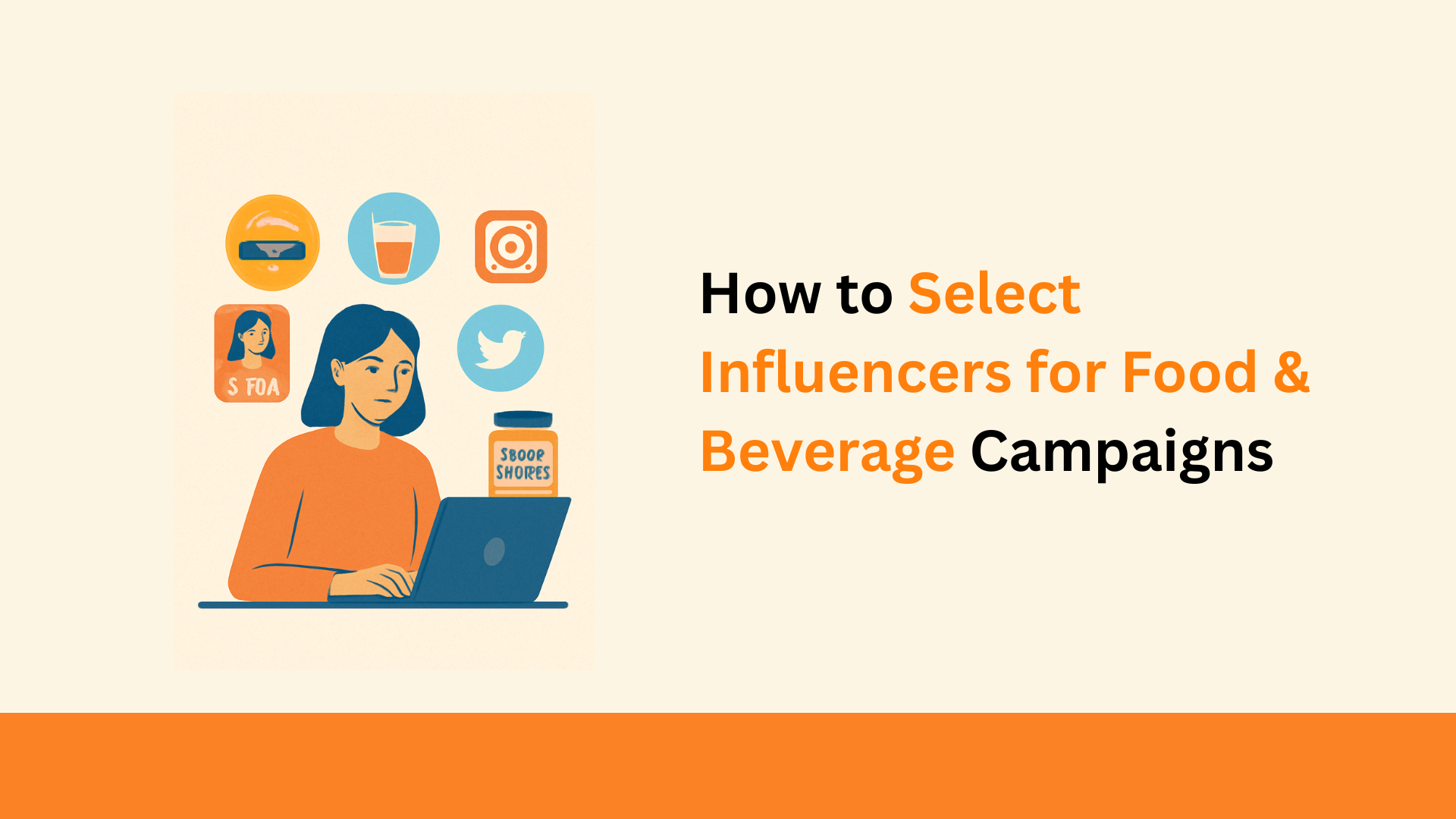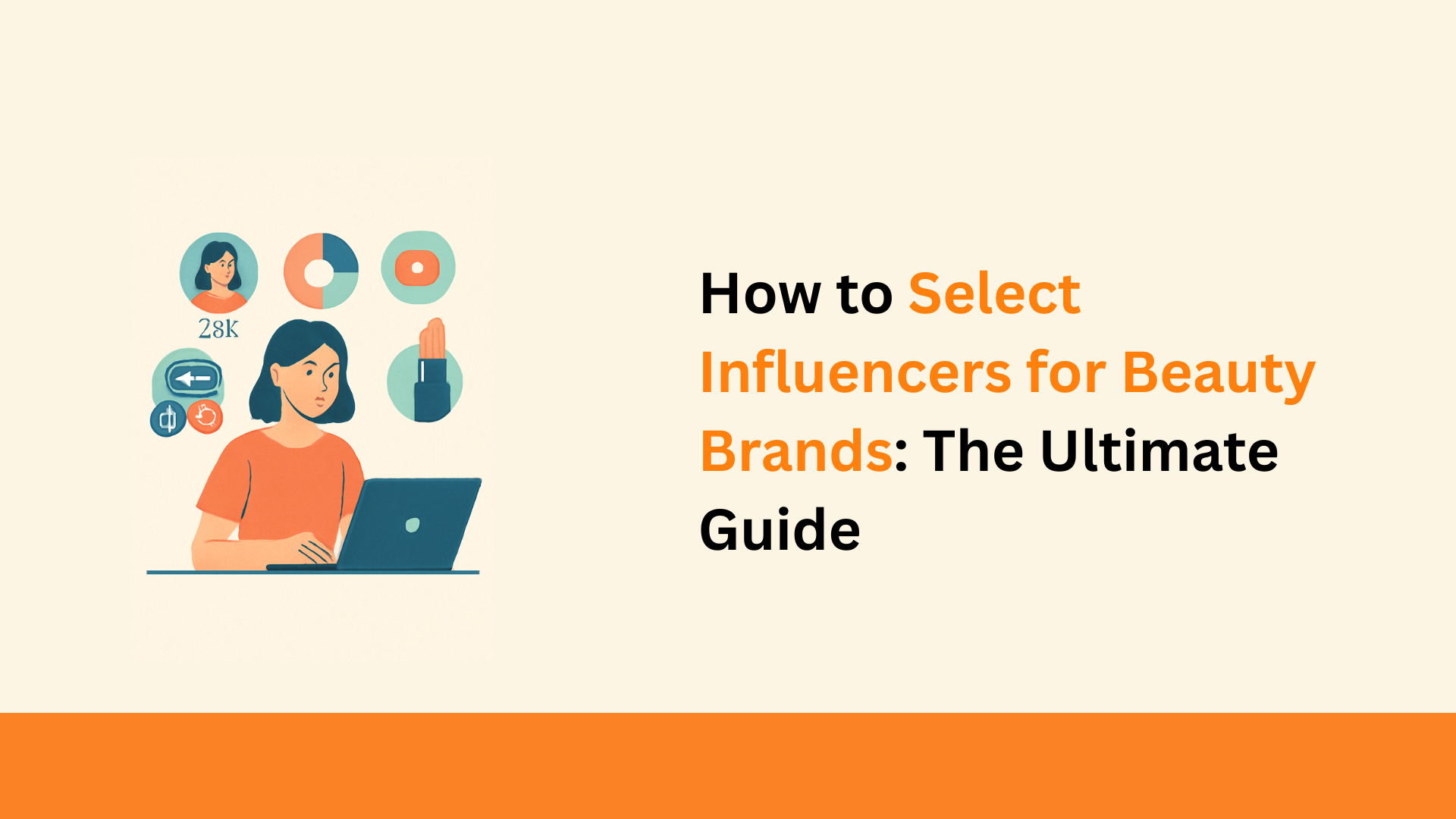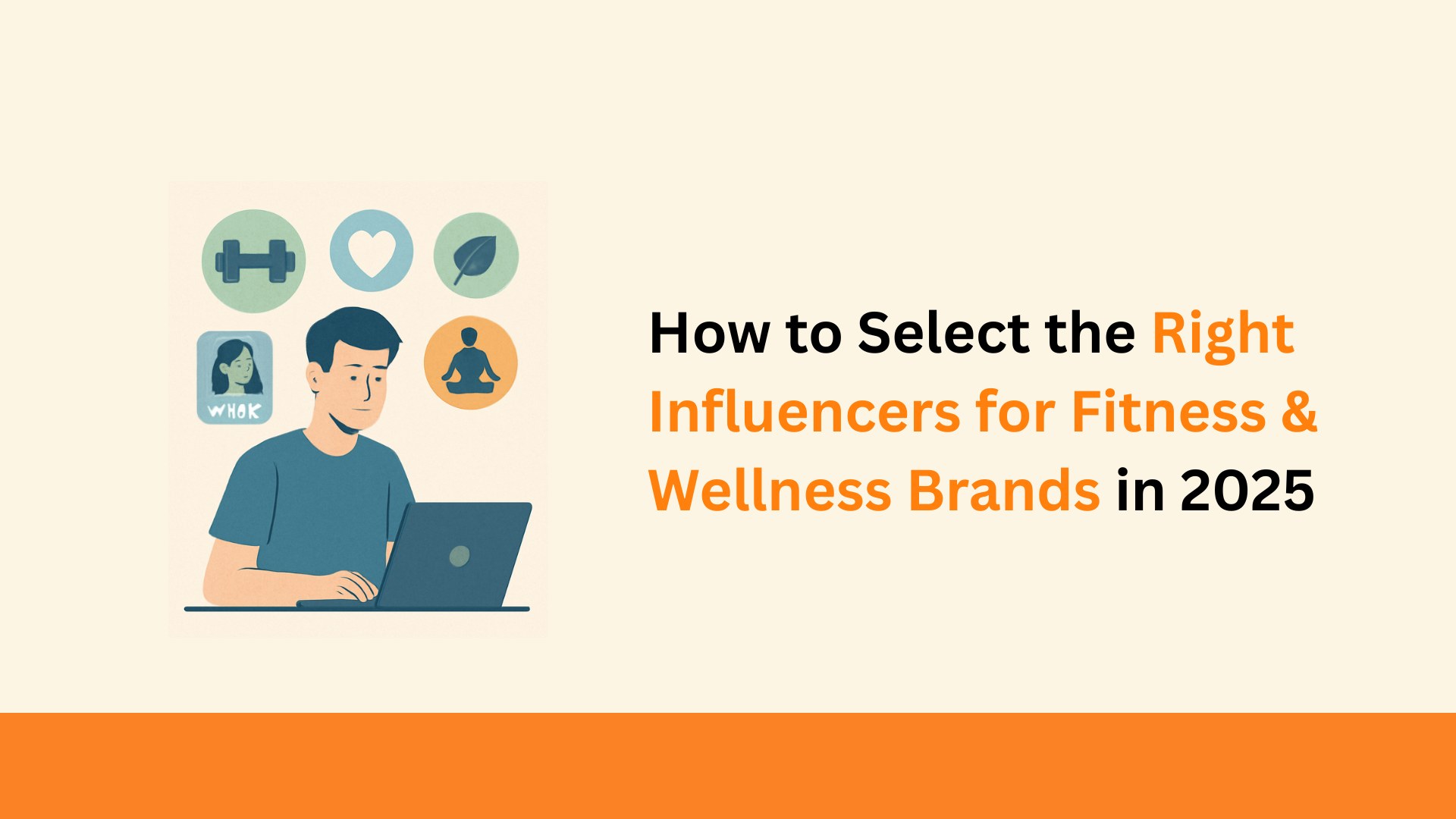TLDR
- Food and beverage campaigns require creators who can authentically showcase sensory experiences through visuals, sounds, and storytelling
- Different campaign types need specialized creators—chefs for recipe demonstrations, local food reviewers for restaurant campaigns, and health experts for functional foods
- Geographic targeting is crucial for restaurant campaigns, with 78% of successful collaborations featuring creators within the delivery radius
- Content quality indicators include natural food styling, authentic reactions, and contextual engagement (recipe saves, location tags)
- Using influencer marketing software streamlines the discovery of creators with specific cuisine expertise and audience demographics
What Makes a Good F&B Influencer?
India’s food and beverage market reached $544 billion in 2023, with digital discovery driving significant growth, making creator partnerships essential for brands seeking to cut through the noise.
Unlike other categories where generalist influencers can drive results, F&B marketing demands specialized creator partnerships that can translate flavors, aromas, and textures into compelling digital content.
The most effective food influencers demonstrate these key qualities:
Sensory Storytelling Ability
Exceptional F&B creators excel at:
- Creating visuals that highlight textures and colors
- Incorporating sounds (sizzle, crunch, pour) that trigger sensory responses
- Using descriptive language that translates taste experiences
- Capturing authentic reaction moments that convey satisfaction
According to Kantar’s F&B Influence Report, content with strong sensory elements drives 3.7x higher engagement than standard product placements.
Category Credibility
Effective food influencers establish domain expertise through:
- Consistent content focus (street food exploration, home cooking, restaurant reviews)
- Demonstrated knowledge (cooking techniques, ingredient information, cultural context)
- Transparent experience sharing (genuine reactions, honest critiques)
- Long-term category commitment rather than occasional food posts
“When consumers follow food creators, they’re seeking trusted guides for their culinary choices. That trust develops through consistent, knowledgeable content creation over time,” notes Kunal Kapoor, celebrity chef and founder of Culinary Lab.
Audience Connection
The best F&B creators maintain strong community engagement via:
- Recipe sharing and cooking guidance
- Local recommendations and insider tips
- Dietary consideration awareness (vegetarian, vegan, gluten-free options)
- Interactive content encourages viewer participation
These fundamental qualities form the foundation of effective influencer selection in the food and beverage space, regardless of specific campaign objectives.
Food Campaigns Are Local—Here’s Why That Matters
Unlike fashion or technology, food and beverage marketing has a uniquely geographic dimension that significantly impacts creator selection:
Delivery Radius Reality
For restaurants, cafes, cloud kitchens, and food delivery brands, geographic targeting is non-negotiable:
- A South Delhi restaurant partnering with North Delhi creators may generate awareness but limited conversions
- Quick-service restaurants need creators within specific delivery zones to drive immediate orders
- Cloud kitchens benefit from hyperlocal creators familiar with neighborhood food preferences
According to Swiggy’s Restaurant Marketing Report, 78% of successful restaurant influencer campaigns featured creators based within the delivery radius of the establishment.
Regional Food Preferences
India’s diverse culinary landscape demands regionalized creator approaches:
- South Indian brands benefit from Tamil/Telugu-speaking creators familiar with local ingredients
- North Indian restaurant chains need Hindi-speaking creators with regional accent familiarity
- Specialty cuisine restaurants require creators with demonstrated appreciation for that culinary tradition
“The most successful restaurant campaigns we’ve executed paired creators with genuine affinity for the specific cuisine with audiences in the exact geographic areas where the restaurant needed foot traffic,” explains Harshil Karia, Founder of Schbang.
Implementing effective geographic targeting requires both manual verification and technological assistance. Using an influencer marketing platform with location filtering helps brands quickly find influencer partners with the right geographic relevance.
Food Influencer Vetting Checklist
Before finalizing creator partnerships, evaluate potential collaborators against these critical criteria:
Content Quality Indicators
Authentic Food Styling: Natural presentation vs. overly manipulated visuals
Original Content: Unique perspectives rather than copied trends
Production Quality: Clear visuals, good lighting, and audible descriptions
Storytelling Approach: Narrative flow vs. disjointed product placements
Brand Integration History: Seamless product inclusions in previous collaborations
Engagement Authenticity Signals
- Contextual Comments: Food-specific discussions vs. generic responses
- Save Rates: High saves on recipe content indicate genuine utility
- Location Tags: Consistent geographic presence aligns with restaurant marketing
- Comment-to-Follower Ratio: Healthy conversation volume relative to audience size
- Fake Follower Analysis: Verification of authentic audience composition
Audience Alignment Factors
Demographic Match: Age/income alignment with target consumers
Geographic Concentration: Followers based in campaign target areas
Dietary Preference Overlap: Vegan, vegetarian, or omnivore audience compatibility
Purchase Intent Signals: Comments indicating dining visits or product purchases
Engagement Rate Consistency: Stable interaction patterns across content
“When vetting food creators, we place special emphasis on save rates for recipe content and comment quality for restaurant reviews. These metrics predict conversion potential far better than basic like counts,” shares Vineet Sharma, VP of Digital Marketing at Jubilant FoodWorks.
Brands implementing comprehensive vetting using these criteria report 40-60% higher campaign performance compared to selection based primarily on follower counts or aesthetic appeal.
Match Creator Type with Campaign Type
Different F&B marketing objectives require specifically tailored creator partnerships:
| Campaign Type | Ideal Creator Type | Selection Criteria | Expected Outcomes |
| Packaged Food Launch | Recipe developer, home cook | Recipe creation skills, high save rates, and family-oriented content | Product usage demonstrations, recipe integration, and pantry staples positioning |
| Restaurant Opening | Local food reviewer, area foodie | Geographic relevance, previous restaurant content, and active local following | Foot traffic generation, menu highlight content, and ambiance showcasing |
| Health Food/Supplement | Nutritionist, fitness creator, health coach | Credentials/expertise, health-conscious audience, educational content style | Ingredient education, benefit explanation, lifestyle integration |
| Beverage Brand | Lifestyle content creator, mixologist, café reviewer | Aesthetic quality, beverage styling skills, and social occasion content | Consumption occasion content, visual appeal emphasis, lifestyle positioning |
| Food Technology/App | Tech-savvy food creator, convenience-focused parent | App usage demonstration ability, problem-solution content style | Feature highlighting, user experience showcase, convenience positioning |
| Seasonal/Festival Campaign | Cultural content creator, traditional recipe specialist | Festival-specific content history, cultural authenticity, and celebration content | Traditional connection, gifting suggestions, festive recipe adaptations |
An influencer marketing agency with F&B specialization can help develop subcategory-specific selection frameworks tailored to particular campaign objectives.
The Power of Creator Categories in F&B Marketing
The F&B space includes several distinct creator categories, each bringing unique strengths to specific campaign types:
Home Chefs & Recipe Developers
Strengths: High trust factor, detailed cooking demonstrations, and practical usage ideas.
Ideal for: Packaged ingredients, cooking aids, kitchen appliances.
Performance indicators: Recipe saves, ingredient questions, recipe attempts
When major packaged food brands partner with home chefs creating family-friendly recipes, they typically see engagement rates 3-4x higher than traditional product promotional content.
Professional Chefs & Culinary Experts
Strengths: Technical expertise, quality positioning, premium associations.
Ideal for: Specialty ingredients, premium kitchenware, upscale restaurant.s
Performance indicators: Technique discussions, culinary knowledge sharing
Professional chef collaborations with kitchen appliance brands typically generate 70-80% higher conversion rates compared to partnerships with non-expert influencers.
Food Reviewers & City Explorers
Strengths: Location-based credibility, honest opinion sharing, and discovery positioning.
Ideal for: Restaurants, cafes, food delivery apps, and cloud kitchens.
Performance indicators: Visit inquiries, location tags, dish recommendation requests
Regional food reviewers can drive significant increases in weekend bookings for new restaurants through authentic review partnerships that highlight signature dishes and ambience.
Health & Nutrition Experts
Strengths: Wellness credibility, ingredient education, and habit formation content.
Ideal for: Functional foods, supplements, health beverages, and organic products.
Performance indicators: Nutrition questions, ingredient investigation, routine integration
Nutritionist partnerships with traditional grain and superfood brands typically result in 2-3x higher conversion rates than celebrity endorsements due to higher educational value.
Lifestyle Creators with Food Focus
Strengths: Aspirational positioning, aesthetic excellence, occasion-based content.
Ideal for: Premium food gifts, specialty beverages, and dining experience.
Performance indicators: Aesthetic appreciation, occasion tagging, aspiration signals
Luxury food gift unboxings by lifestyle creators consistently generate 4-5x higher engagement than product-focused content for the same brands, particularly during festive seasons.
How Qoruz Simplify F&B Influencer Discovery
Identifying the perfect creator match becomes significantly more efficient with specialized technology:
Advanced Filtering Capabilities
An influencer marketing platform like Qoruz enables precise targeting through:
- Cuisine specialization filtering: Identify creators focusing on specific food categories
- Geographic targeting: Find creators based in exact campaign locations
- Audience demographic matching: Align creator followers with consumer profiles
- Content performance analysis: Filter by engagement on food-specific content
- Brand mention history: Identify previous competitor collaborations
Using specialized tools for discovery can transform selection from subjective guesswork to data-driven decision making. Brands can identify creators whose audiences precisely match their customer profiles, resulting in significantly higher conversion rates.
FAQs
1. How do I choose influencers for a food product?
Select creators whose content style, audience demographics, and culinary focus align with your product positioning. Verify they’ve created similar recipe content, evaluate their demonstration skills, analyze their audience engagement quality, and confirm geographic relevance to your distribution areas.
2. What should I look for in a restaurant influencer?
Prioritize creators based in your restaurant’s geographic service area with a demonstrated history of restaurant visits and reviews. Check their previous content for honest, detailed observations, verify their audience is local, and analyze comment quality for indicators of visit intent based on reviews.
3. Should I hire creators with high reach or high save rates?
For most F&B campaigns, save rates and comment quality predict performance better than raw reach. High saves on recipe content indicate practical value, while detailed location-specific comments on restaurant content suggest stronger visit intent than generic engagement on high-reach accounts.
4. Can nano-influencers drive real results in F&B campaigns?
Yes, particularly for location-specific campaigns like restaurant launches. Data from 500+ restaurant campaigns shows nano-influencers (under 10K followers) with local credibility often drive higher foot traffic conversion than larger creators, especially when their audience is concentrated within the restaurant’s delivery radius.
5. How can I check if a food influencer’s followers are real?
Use specialized tools to analyze follower growth patterns, engagement consistency, audience demographics, and comment quality. Watch for red flags like sudden follower spikes, engagement that doesn’t match audience size, or generic comments lacking food-specific language. Platforms like Qoruz provide automated authenticity verification.



